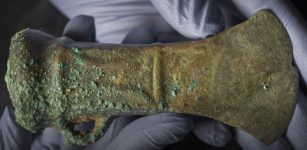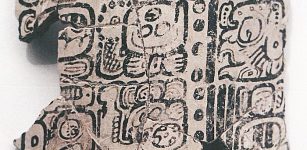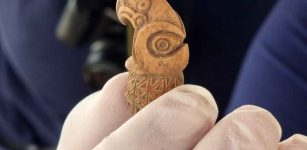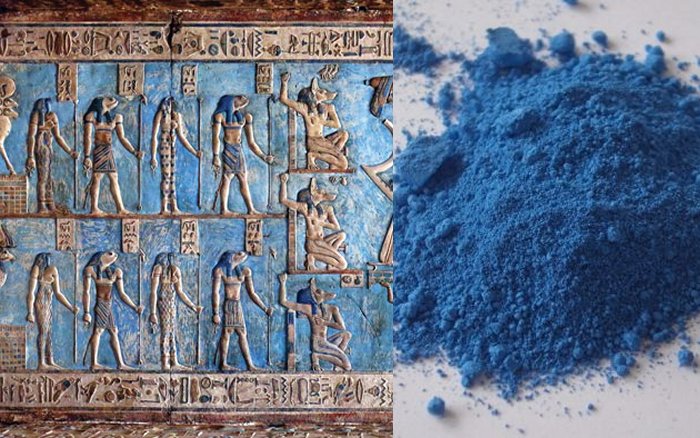Egyptian Blue: World’s Oldest Artificial Pigment
AncientPages.com - Question: What was the Egyptian blue?
Answer: The Egyptian blue is the world’s oldest artificial pigment. It appeared about 5,000 years ago in a tomb painting dated to the reign of Ka-sen, the last king of Egypt's First Dynasty.
Scientists have discovered that the Egyptian blue pigment has extraordinary properties and will enable us not only to reconstruct the past, but also possibly to shape the technological future.
The material giving Egyptian blue its color is calcium copper silicate. It was made by grinding sand, lime and copper (or copper ore) and heating the mixture in a furnace.
See also: Ancient Egyptians Had The First Governmental Health Care System
Egyptian blue was widely used in ancient times as a pigment in painting, such as in wall paintings, tombs, mummies’ coffins and a ceramic glaze known as Egyptian faience. The fact that it was not available naturally meant that its presence indicated a work that had considerable prestige. Its use spread throughout Egypt, Mesopotamia, Greece, and the far reaches of the Roman Empire. It was often used as a substitute for lapis lazuli, an extremely expensive and rare mineral sourced in Afghanistan.
Scientists have noticed that when irradiated with visible light, Egyptian blue emits near-infrared rays with exceptional strength, with even single particles of the pigment detectable from a distance of a few yards.
This suggests Egyptian blue could have a variety of modern applications. For example, it could soon be used in advanced biomedical engineering. Expanding on the ancient Egyptian concept with the pigment's near-infrared-emitting property, scientists can also use it as a nano-ink.
So, the Egyptian blue is certainly more than just a color.
AncientPages.com
Expand for referencesSource:
More From Ancient Pages
-
 How Ramesses II Became The Greatest Pharaoh In Egypt
Featured Stories | Jun 6, 2021
How Ramesses II Became The Greatest Pharaoh In Egypt
Featured Stories | Jun 6, 2021 -
 Discovered Near Arctic: Mysterious Lost Medieval Civilization And Puzzling Ancient Mummy
Archaeology | Jul 4, 2015
Discovered Near Arctic: Mysterious Lost Medieval Civilization And Puzzling Ancient Mummy
Archaeology | Jul 4, 2015 -
 Mysterious Havering Hoard – Largest Ever Bronze Age Hoard Discovered In London
Archaeology | Oct 21, 2019
Mysterious Havering Hoard – Largest Ever Bronze Age Hoard Discovered In London
Archaeology | Oct 21, 2019 -
 Mystery Of Gribshunden – Danish Royal Sunken Ship Sheds New Light On Psychological Warfare In The Middle Ages
Archaeology | Apr 14, 2017
Mystery Of Gribshunden – Danish Royal Sunken Ship Sheds New Light On Psychological Warfare In The Middle Ages
Archaeology | Apr 14, 2017 -
 Drought Encouraged Attila’s Huns To Attack The Roman Empire – New Study
Archaeology | Dec 15, 2022
Drought Encouraged Attila’s Huns To Attack The Roman Empire – New Study
Archaeology | Dec 15, 2022 -
 Are Bones Of Apostle Peter Hidden Inside A 1000-Year-Old Roman Church?
Archaeology | Sep 16, 2017
Are Bones Of Apostle Peter Hidden Inside A 1000-Year-Old Roman Church?
Archaeology | Sep 16, 2017 -
 On This Day In History: Vespasian Was Elected The Roman Emperor – On July 1, 69 A.D.
News | Jul 1, 2016
On This Day In History: Vespasian Was Elected The Roman Emperor – On July 1, 69 A.D.
News | Jul 1, 2016 -
 ‘Face Of First European’ – Oldest Fossil Of European Human Ancestor Found At Spain’s Atapuerca Archaeological Site
Archaeology | Jul 9, 2022
‘Face Of First European’ – Oldest Fossil Of European Human Ancestor Found At Spain’s Atapuerca Archaeological Site
Archaeology | Jul 9, 2022 -
 Mystery Of The Brave Viking Chief Buried On The Gokstad Ship
Featured Stories | Mar 14, 2016
Mystery Of The Brave Viking Chief Buried On The Gokstad Ship
Featured Stories | Mar 14, 2016 -
 Ancient Egyptian Tombs With Stunning Trove Of Artifacts And Human Remains Unearthed In Saqqara
Archaeology | Jan 17, 2024
Ancient Egyptian Tombs With Stunning Trove Of Artifacts And Human Remains Unearthed In Saqqara
Archaeology | Jan 17, 2024 -
 Painted Komkom Vase With Longest Hieroglyphic Text Unearthed In Belize
Archaeology | Apr 24, 2019
Painted Komkom Vase With Longest Hieroglyphic Text Unearthed In Belize
Archaeology | Apr 24, 2019 -
 Ancient People In Peru Had A Unique Response To The Looting And Destruction Of Their Ancestors’ Graves
Archaeology | Feb 3, 2022
Ancient People In Peru Had A Unique Response To The Looting And Destruction Of Their Ancestors’ Graves
Archaeology | Feb 3, 2022 -
 Ancient Mystery Of Giant Mounds Of Jerusalem Built For Unknown Reasons – Archaeologists Are Still Baffled
Archaeoastronomy | Aug 24, 2020
Ancient Mystery Of Giant Mounds Of Jerusalem Built For Unknown Reasons – Archaeologists Are Still Baffled
Archaeoastronomy | Aug 24, 2020 -
 Strange 1,200-Year-Old Anglo-Saxon Artifact Used For Unknown Purpose Found In Norfolk, UK
Archaeology | Jan 18, 2024
Strange 1,200-Year-Old Anglo-Saxon Artifact Used For Unknown Purpose Found In Norfolk, UK
Archaeology | Jan 18, 2024 -
 On This Day In History: Ferdinand Magellan Discovers Guam – On Mar 6, 1521
News | Mar 6, 2017
On This Day In History: Ferdinand Magellan Discovers Guam – On Mar 6, 1521
News | Mar 6, 2017 -
 Ancient Irrigation System Could Boost Water Availability In Peru
Archaeology | Jun 26, 2019
Ancient Irrigation System Could Boost Water Availability In Peru
Archaeology | Jun 26, 2019 -
 What Happened To The Homo Sapiens In The Thar Desert When They Encountered The Indian Monsoon System
Archaeology | Oct 5, 2021
What Happened To The Homo Sapiens In The Thar Desert When They Encountered The Indian Monsoon System
Archaeology | Oct 5, 2021 -
 On This Day In History: Coverdale Bible Printed In English For The First Time – On Oct 4, 1535
News | Oct 4, 2016
On This Day In History: Coverdale Bible Printed In English For The First Time – On Oct 4, 1535
News | Oct 4, 2016 -
 Rare 2,500-Year-Old Scythian Bone Sceptre Discovered In Bulgaria
Archaeology | Oct 3, 2023
Rare 2,500-Year-Old Scythian Bone Sceptre Discovered In Bulgaria
Archaeology | Oct 3, 2023 -
 First Crusade Was Launched In 1095
Ancient History Facts | Jun 19, 2018
First Crusade Was Launched In 1095
Ancient History Facts | Jun 19, 2018

